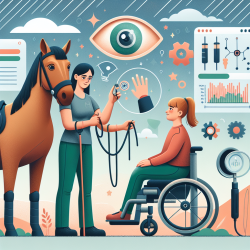The COVID-19 pandemic has significantly altered the landscape of mental health care, prompting a rapid shift from in-person to telehealth services. This transition disrupted established processes for identifying and assessing suicide risk, presenting both challenges and opportunities for improvement. The research article "Detecting and Assessing Suicide Ideation During the COVID-19 Pandemic" by Simon et al. (2021) provides valuable insights into how healthcare systems can adapt to these changes.
The study, conducted by Kaiser Permanente Washington (KPWA), outlines a series of workflow modifications designed to ensure the continuity of suicide risk assessments during telehealth visits. Here are the key takeaways for practitioners looking to enhance their skills in this critical area:
Key Findings and Implementation Strategies
- Automated Distribution of Questionnaires: One of the most effective strategies was the automated distribution of monitoring questionnaires via the Electronic Health Record (EHR) patient portal. This ensured that patients received and completed these questionnaires prior to their telehealth appointments.
- Automated Alerts for Clinicians: The study implemented automated alerts to notify clinicians when a patient's responses indicated a high risk of suicide. This facilitated timely and appropriate follow-up actions.
- Structured Suicide Risk Assessments: For patients reporting frequent suicidal ideation, structured assessments using the Columbia-Suicide Severity Rating Scale (C-SSRS) were conducted. These assessments were crucial for identifying the severity of the risk and planning appropriate interventions.
- Continuous Monitoring and Adaptation: The proportion of mental health visits with completed screening questionnaires initially fell but gradually recovered through continuous monitoring and process improvements. By the end of 2020, the rates of completed suicide risk assessments had nearly returned to pre-pandemic levels.
Recommendations for Practitioners
To improve your skills in detecting and assessing suicide ideation in a telehealth setting, consider the following recommendations:
- Leverage Technology: Utilize the capabilities of your EHR system to automate the distribution of screening questionnaires and set up alerts for high-risk indicators.
- Conduct Structured Assessments: Implement structured risk assessments like the C-SSRS to systematically evaluate the severity of suicidal ideation.
- Engage in Continuous Improvement: Regularly review and adapt your processes based on data and feedback to ensure that screening and risk assessment rates remain high.
- Collaborate with Multidisciplinary Teams: Work closely with other healthcare providers, including consulting nurses, to ensure a coordinated and timely response to identified risks.
Implementing these strategies can significantly enhance your ability to identify and address suicide risk in a telehealth setting, ultimately leading to better outcomes for your patients.
To read the original research paper, please follow this link: Detecting and Assessing Suicide Ideation During the COVID-19 Pandemic.










